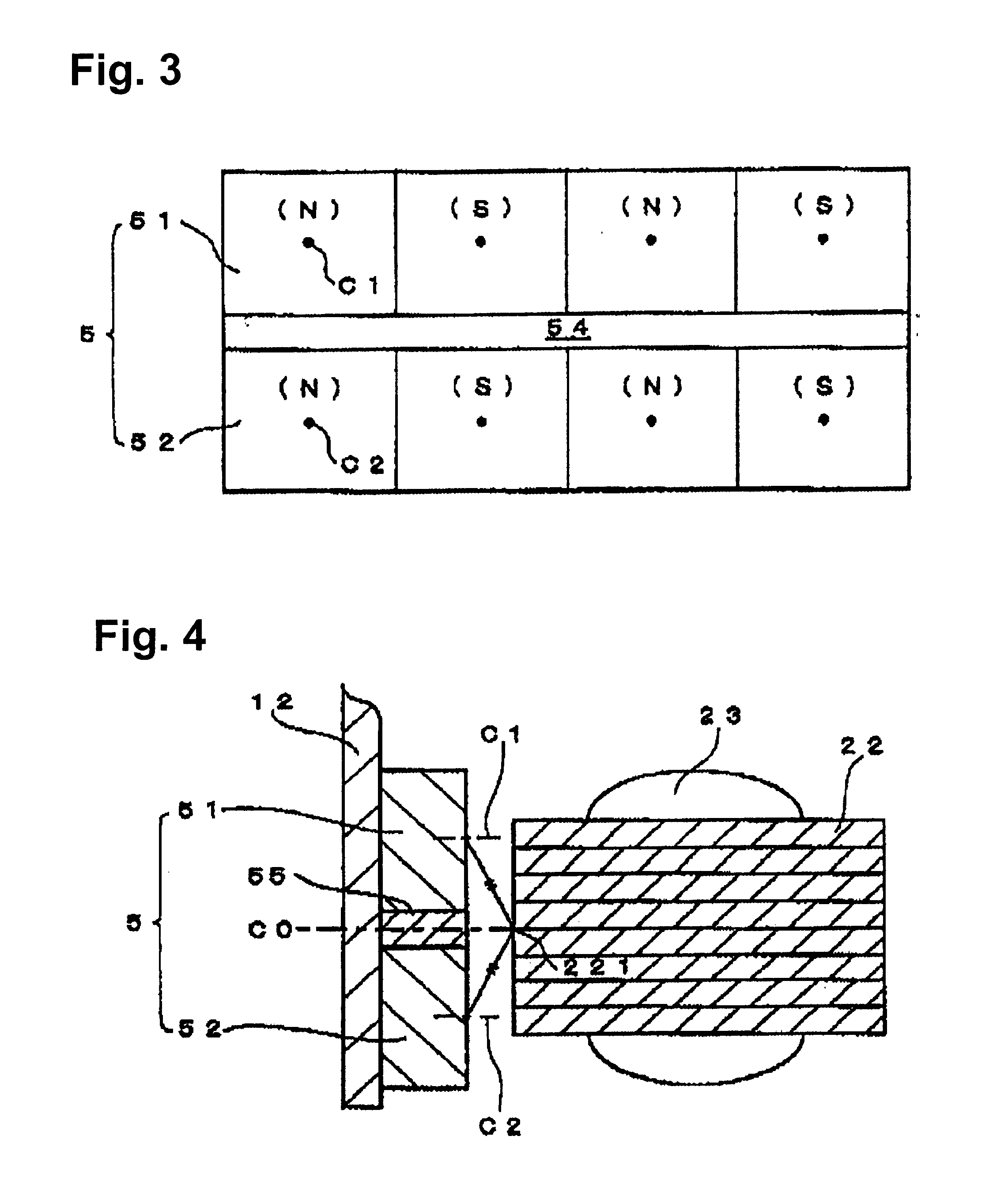Circumferential confronting type motor
a technology of confronting type and motor, which is applied in the direction of magnetic circuit rotating parts, magnetic circuit shape/form/construction, instruments, etc., can solve the problems of motor failure to rotate, bearing life, and escalating parts cos
- Summary
- Abstract
- Description
- Claims
- Application Information
AI Technical Summary
Benefits of technology
Problems solved by technology
Method used
Image
Examples
embodiment 1
FIG. 1 is a longitudinal cross-sectional view indicating the first embodiment in which a circumferential confronting type motor according to the present invention is applied to a deflection scanning device. The circumferential confronting type motor in FIG. 1 is primarily composed of a rotor assembly 1 and a stator assembly 2. The rotor assembly 1 is equipped with a generally cylindrically-shaped rotor 10, a drive magnet 5 mounted on an outer circumference side of the rotor 10 via a magnet yoke 12, and a polygon mirror 6 fixed to the rotor 10.
The rotor 10 has a cylinder section 101 in which a shaft hole 13 is formed, and a fixed shaft 20 is inserted in the shaft hole 13. An abrasion-resistant film made of electroless nickel plating or hard Alumite film is provided on an inner circumference surface of the shaft hole 13, while on an outer circumference surface of the fixed shaft 20 herringbone-shaped dynamic pressure generating grooves, as well as a lubricating resin film, are formed....
embodiment 2
FIGS. 4 and 5 show another embodiment of a circumferential confronting type motor in accordance with the present invention. FIG. 4 is a cross-sectional view of key parts of the circumferential confronting type motor, and FIG. 5 is a developed view of a drive magnet 5. Elements identical to those in the first embodiment are assigned the same numbers and duplicate descriptions are omitted.
In FIG. 4, a drive magnet 5 is equipped with a first divided magnetized section 51 and a second divided magnetized section 52, and the divided magnetized sections are structured as magnets independent from one another across a non-magnetized section 55, which is a void space. The divided magnetized sections 51 and 52 have a magnetic center C1 and a magnetic center C2, respectively, formed at positions symmetrical to a magnetic center C0 in the axial direction of an armature core 22, and the first divided magnetized section 51 and the second divided magnetized section 52 have the same thickness and sh...
embodiment 3
FIG. 6 is a cross-sectional view of key parts of a circumferential confronting type motor in accordance with another embodiment of the present invention. Elements identical to those in the first embodiment are assigned the same numbers and duplicate descriptions are omitted.
In FIG. 6, a drive magnet 5 is mounted on an inner circumference surface of a magnet yoke 12, which has a positioning section 121 that abuts against an end surface 56 of the drive magnet 5 and positions the drive magnet 5 in the axial direction. The positioning section 121 can be easily formed by using a punch from an outer circumference side to an inner circumference side of the magnetic yoke 12, which is made of a magnetic metal, to cause a plastic deformation that protrudes inward in the radial direction. The positioning section 121 can be formed along the entire circumference at the same height in the axial direction of the magnet yoke 12, or it can be formed in a plurality of positions at an interval in the ...
PUM
| Property | Measurement | Unit |
|---|---|---|
| skew angle | aaaaa | aaaaa |
| skew angle | aaaaa | aaaaa |
| magnetic | aaaaa | aaaaa |
Abstract
Description
Claims
Application Information
 Login to View More
Login to View More - R&D
- Intellectual Property
- Life Sciences
- Materials
- Tech Scout
- Unparalleled Data Quality
- Higher Quality Content
- 60% Fewer Hallucinations
Browse by: Latest US Patents, China's latest patents, Technical Efficacy Thesaurus, Application Domain, Technology Topic, Popular Technical Reports.
© 2025 PatSnap. All rights reserved.Legal|Privacy policy|Modern Slavery Act Transparency Statement|Sitemap|About US| Contact US: help@patsnap.com



